Anaerobic and aerobic bacteria for septic tanks: we understand the rules of wastewater treatment
The best solution for processing sewage in the countryside is to install a local treatment plant - a septic tank or biological treatment plant.
Bacteria for septic tanks, useful microorganisms that do not harm the environment, act as components that accelerate the decay of organic waste. Agree, in order to choose the composition and dose of bioactivators correctly, you need to understand the principle of their work and know the rules for their use.
These questions are detailed in the article. The information will help owners of the local sewage system to improve the functioning of the septic tank and facilitate its maintenance.
The content of the article:
Ecological treatment of sewage
Information about aerobes and anaerobes will interest those who have decided buy a septic tank for a suburban area or wants to “modernize” an existing cesspool.
Having selected the necessary types of bacteria and determining the dosage (according to the instructions), it is possible to improve the operation of the simplest construction of the accumulative type or to establish the functioning of a more complex device - a two-three-chamber septic tank.
Biological processing of organics is a natural process that has long been used by humans for economic purposes.
The simplest microorganisms, feeding on human waste, in a short period of time turn them into a solid mineral sediment, clarified liquid and fat that floats to the surface and forms a film.
The use of bacteria for domestic and sanitary purposes is advisable for the following reasons:
- Natural microorganisms developing and living according to the laws of nature do not harm the surrounding flora and fauna. This fact must be taken into account by the owners of personal plots that use the free territory for growing garden and garden crops, arranging lawns and flower beds.
- There is no need to acquire aggressive chemicals, unlike natural elements that negatively affect soil and plants.
- The smell characteristic of domestic wastewater is felt much weaker or disappears altogether.
- The cost of bioactivators is low compared to the benefits they bring.
In connection with the pollution of soil and water bodies, the ecology problem affected summer plots, villages and territories with suburban new buildings - cottage villages. Thanks to the action of bacteria-orderlies, it can partially be solved.
Two types of bacteria are involved in the sewage system: anaerobic and aerobic. More detailed information about the vital signs of the two types of microorganisms will help you understand the principle of the action of septic tanks and storage, as well as the nuances of servicing wastewater treatment plants.
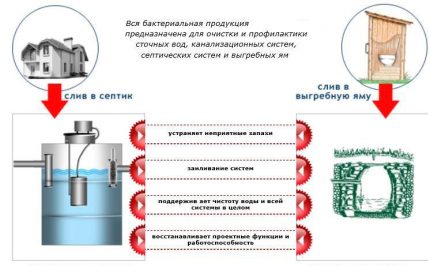
Basic principles of anaerobic cleaning
Microorganisms that can function in oxygen-free space are called anaerobic bacteria or anaerobes. We will try to figure out what place they occupy in the wastewater treatment system.
Where did the anaerobes come from
It should be understood that strains of anaerobic bacteria for household septic tanks were not specially bred artificially (although the production of new, more active strains has now been established), they have always been part of nature.
Microorganisms that can exist without oxygen develop in marshy and simply moist soil, in silt, in the soil at great depths. Some species are actively involved in the formation of humus and humus, formed by decaying dead plants and dead animals.
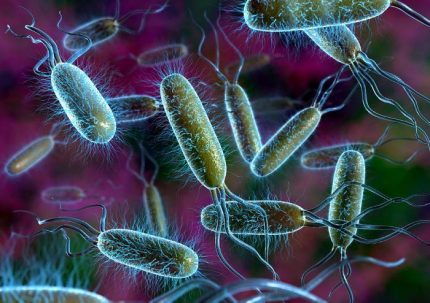
Anaerobic-type drainage water is processed in sealed tanks.An example of such a capacity in the country is a street toilet “birdhouse” with cesspool. The fermentation process is carried out by anaerobic bacteria, which in the process of their life emit methane and heat.
The anaerobic cleaning principle is also used in household devices (drives, septic tanks) and industrial buildings (digesters). Fermentation by anaerobes is actively used in livestock farms and poultry farms.
Bacteria
For the existence of microorganisms, special conditions are necessary, among which:
- isolation - lack of oxygen, with the exception of facultative anaerobes;
- temperature condition - from + 9ºС to + 37ºС, the optimal value is + 28ºС;
- pH value - acidity level from 6 to 8;
- regularity of cleaning - excavation of solid sediment.
Due to the fermentation process, some of the substances sink to the bottom and decay, the other rises to the top. The liquid remains cloudy, often has a black tint. If a large amount of oxygen gets into the reservoir, the bacteria may die.
Negative temperature is also a primary threat, so cesspools are recommended to be insulated.
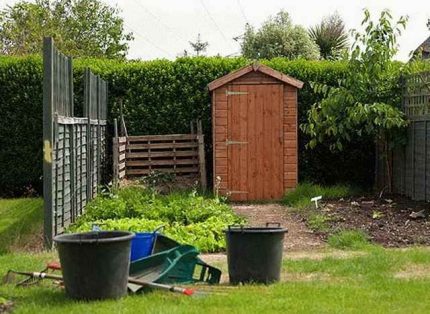
For normal life, anaerobes need a liquid medium, that is, at least 2/3 of the tank must be filled with water. If you do not call the scavengers in time, the amount of solid sediment will reach a critical point and the bacteria will begin to die.
If the volume of the drive does not match the number of residents, the capacity will have to be emptied quite often - 2-3 times a month. Therefore, the choice of a septic tank must be carefully considered, evaluate the parameters and compare them with the upcoming operating conditions.
Read more about the selection of a treatment plant in this article.
How does anaerobic cleaning take place
The decomposition of organic matter in the accumulation pits occurs in two stages. At first, acidic fermentation can be observed, accompanied by a large amount of unpleasant odor.
This is a slow process, during which primary sludge of swamp or gray color is formed, which also emits a pungent odor. From time to time, pieces of sludge come off the walls and rise up along with gas bubbles.
Over time, gases caused by acidification fill the entire volume of the tank, displace oxygen, and create an environment ideal for the development of anaerobic bacteria. From this moment, the alkaline decomposition of sewage begins - methane fermentation.
It has a completely different nature and, accordingly, other results. For example, a specific odor completely disappears, and silt acquires a very dark, almost black color.

If a small part of alkaline sludge with anaerobes is placed in a septic tank or in the receiving chamber, the decomposition process will be more efficient, and the oxidation period will be much faster.
In the absence of live sludge, it is necessary to purchase a bioactivator that is suitable in composition — a solution or dry substance in the form of tablets or powder, which is a complex of “sleeping” anaerobic bacteria for a septic tank.
Thanks to anaerobes, sewage biomass in a cesspool decomposes faster into solid sediment, gases and liquid, and in bicameral septic tank cleared by about 65-70%.
Benefits of Anaerobic Cleaning:
- small volume of bacterial biomass;
- effective mineralization of organics;
- lack of aeration, therefore, savings on additional equipment;
- the possibility of using methane (in large quantities).
The disadvantages include strict observance of the conditions of existence: a certain temperature, pH, regular removal of solid sediment. In contrast to activated sludge, mineralized substances precipitated are not a nutrient medium for plants and are not used as fertilizers.
VOC regimens using anaerobic bacteria
The simplest device in which anaerobic bacteria can live and multiply is a drain pit. Modern cesspools are concrete or plastic sealed tanksinstalled in the soil below the freezing level.
HDPE products can be purchased at specialized companies or on manufacturers' websites, concrete - build from reinforced concrete rings independently, with the help or under the supervision of specialists.

The productivity of the structure increases with the advent of additional functional cameras. The most common designs have 2-3 compartments, the first of which plays the role of a sump, and the next - tanks for cleaning and clarification.
To create a favorable environment for the life of microorganisms, a porous material, such as crushed stone, is placed at the bottom of the container.
Post-treatment of clarified liquid occurs in filter well or at filter fieldby which water enters the ground. A suitable type of soil (loam, sand, sandy loam), as well as a low level of groundwater, are necessary for their construction.
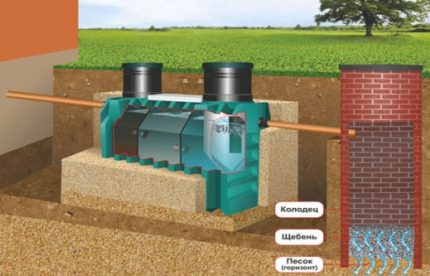
To maintain balance in the cameras, regular care is required. It consists in removing solid sediment from the sump, pumping excess activated sludge from the second chamber in the first, adding bioactive activators (in case of death or with an insufficient number of anaerobes).
Features of aerobic cleaning
Aerobes, unlike anaerobes, cannot exist without oxygen. In the biological wastewater treatment system, they occupy their equally important niche.
The conditions created for the development of anaerobes are absolutely not suitable for the life of another type of bacteria - aerobes. They cannot form spores in a confined space, deprived of air access, and therefore grow and process sewage.
In order for the aerobic system to fully realize its potential, the ventilation hole is not enough, a forced supply of oxygen is necessary.
The air tank supply system consists of several parts. The main function (air injection) performs compressor for septic tank. Usually it is installed in a warm room inside the house, near the outlet of sewer communications.An air duct connects the compressor to the septic tank and passes in the same trench with pipes laid in the ground.
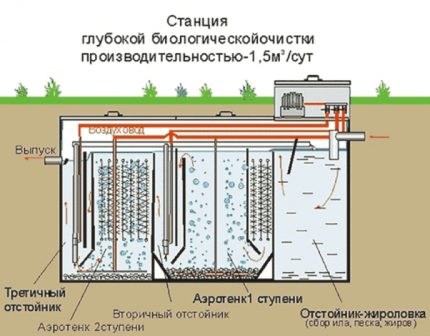
Saturation of effluents with oxygen occurs with the help of perforated tubes, aerators, lowered into the water. The air supply can be regulated or completely shut off by valves located near the hatch.
Air leaves the holes and, moving upward in the form of small bubbles, enriches the drains with oxygen. Aerators need to be cleaned from time to time so that the oxygen supply process does not stop.
When the first VOCs were installed, the problem of gradual flushing of aerobic bacteria for the septic tank arose. It was decided by loading additional devices into the tank - textile shields and plastic "brushes".
A fine-pile fabric and bristles made of a polymer material prevent the leaching of activated sludge and serve as the basis for its growth.
As the excess sludge accumulates, it is removed and used as fertilizer for growing vegetables, temporarily placed in compost heaps.
The main enemies of biological treatment are chemical detergents and antibiotics dissolved in sewage. They are harmful to all kinds of bacteria, therefore aggressive chemicals (for example, chlorine and solutions containing it) are forbidden to merge into a septic tank.
Advantages and disadvantages of using aerobes
Almost all existing deep biological treatment plants incorporate aerobic chambers, since “oxygen” bacteria have some advantages over anaerobes.
They destroy the impurities dissolved in water that remain after mechanical and anaerobic treatment. A solid precipitate does not form, and plaque can be removed manually.

Activated sludge, which is the result of aerobic activity, is environmentally friendly and, unlike chemicals, benefits vegetation growing on the site. Instead of the unpleasant odor characteristic of acidifying effluents in cesspools, carbon dioxide comes out.
But the main advantage is the quality of water treatment - up to 95-98%. The disadvantage is the volatility of the system.
In the absence of electrical power, the compressor stops supplying oxygen, and bacteria can die if left idle for a long time without aeration. Both types of bacteria, aerobes and anaerobes, are sensitive to household chemicals, therefore, when using biological treatment, it is necessary to control the composition of wastewater.
Aerobic VOCs
The clarification of sewage by aerobes is carried out in deep biological treatment plants. As a rule, such a station consists of 3-4 cameras.
The first compartment is a sump in which waste is divided into various substances, the second is used for anaerobic treatment, and already in the 3 (in some models and in 4) compartment aerobic clarification of the liquid is performed.

After a three-four-stage treatment, water is used for household needs (irrigation) or is supplied for additional treatment to one of the treatment facilities:
- filter well;
- filtering field;
- infiltrator.
But sometimes, instead of one of the structures, soil drainage is arranged, in which post-treatment takes place in natural conditions. In sandy, gravel and gravelly soils, the smallest organic residues are processed by aerobes.
Through clays, loams, almost all sandy loams except for the sandy and highly fractured version, water will not be able to seep into the underlying layers. Clay rocks also do not produce soil post-treatment, because have extremely low filtration qualities.
If the geological section on the site is represented by clay soils, soil post-treatment systems (filtration fields, absorption wells, infiltrators) are not used.
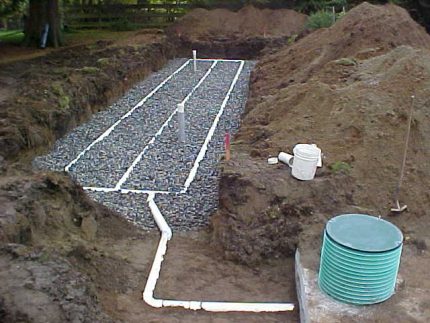
The filtration field is a branched system of perforated pipes (drains) extending from the distribution well. Treated effluents enter first into the well, then into drains buried in the ground. The pipes are equipped with risers, through which oxygen is supplied, which is necessary for aerobic bacteria.
The infiltrator is a finished product from HDPE, the last stage of VOC for the post-treatment of clarified effluents. It is buried in the ground next to the septic tank, placed on a drainage pillow from crushed stone. The installation conditions for the infiltrator are the same - light, water-permeable soil and a low level of groundwater.
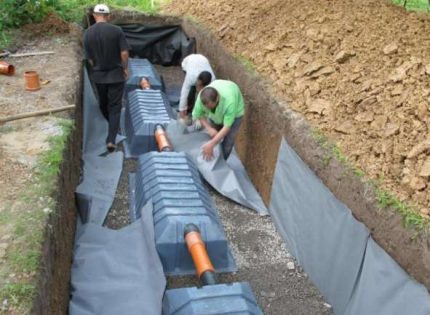
The filter well at first glance resembles a storage tank, but has one significant difference - a penetrating bottom. The lower part remains open, covered with a drainage layer on 1-1.2 m (crushed stone, gravel, sand). Mandatory ventilation and technical hatch.
If additional treatment is not required, sewage treated up to 95 - 98% is directly discharged from the septic tank into a roadside ditch or ditch.
Rules for the use of bioactivators
To start or strengthen the biological treatment process, additives are sometimes necessary - bioactivators in the form of dry powders, tablets or solutions.
They replaced bleach, which caused the environment more harm than good. For the production of bioactivators, the most persistent and active strains of bacteria living in the earth were selected.
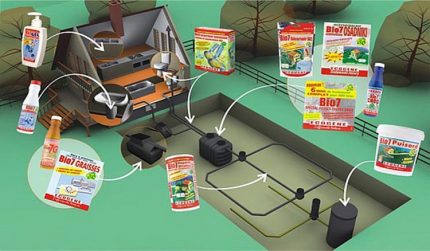
Preparations that help accelerate the decay of organics usually have a universal complex composition, sometimes narrowly targeted. For example, there are starter varieties that help revitalize the cleaning process after winter preservation or prolonged downtime.
Narrowly targeted species are aimed at solving a specific problem, for example, removing large amounts of fat from sewer pipes or splitting concentrated soap drains.
The use of bioactivators in VOCs and cesspools has several advantages.
Regular users note the following positive points:
- reduction of solid waste by 65-70%;
- destruction of pathogenic microflora;
- the disappearance of a sharp sewer smell;
- faster flow of the cleaning process;
- prevention of blockages and siltation of various parts of the sewer system.
For the quick adaptation of bacteria, special conditions are necessary, for example, a sufficient amount of liquid in a container, the presence of a nutrient medium in the form of organic waste, or a comfortable temperature (on average from + 5 ° C to + 45 ° C).
And do not forget that living bacteria for the septic tank are threatened by chemicals, petroleum products, antibiotics.
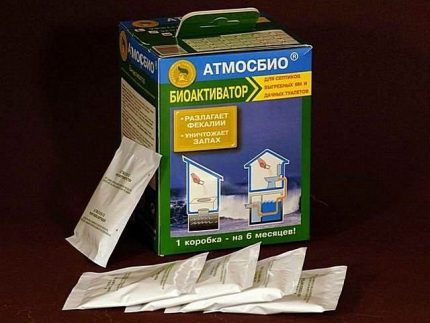
There is no shortage of the biological product market, with the exception of domestic brands and foreign brands. The most famous brands - "Atmosbio », "Dr. Robik", "BioExpert", "Vodogray", Saneks, Microzim Sepi Trit, "Biosept".
Conclusions and useful video on the topic
The presented videos contain useful material on the selection and use of biological products.
Practical experience of using bioactivators in the village:
Video review of the bioactivator "Restroom strength":
The review of the biological product "Economy country":
Rules for the use of bioactivator "Vodograi":
As you can see, the use of live bacteria for cesspools or septic tanks helps to quickly and economically solve the problem of cleaning sewage.
Microorganisms increase the efficiency of VOCs without harming the environment. To create the most comfortable conditions for the life of bacteria, follow the instructions and do not forget to timely service the treatment facilities.
There is something to supplement, or there were questions about the topic of choosing and using bacteria for septic tanks - you can leave comments on the publication. The contact form is located in the lower block.

 Bacteria for Dr. Robik septic tanks: purchase tips and instructions for use
Bacteria for Dr. Robik septic tanks: purchase tips and instructions for use 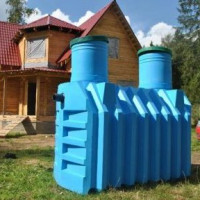 Which septic tank to choose: rating of the best sewage treatment plants
Which septic tank to choose: rating of the best sewage treatment plants 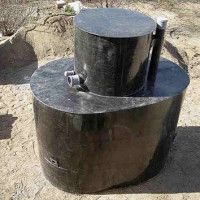 Review of septic tanks “Mole”: device, advantages and disadvantages, comparison with competitors
Review of septic tanks “Mole”: device, advantages and disadvantages, comparison with competitors 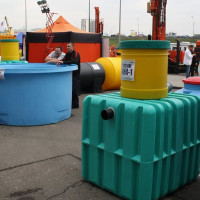 Budget septic tanks for giving without pumping: the best manufacturers of septic tanks without pumping in the market
Budget septic tanks for giving without pumping: the best manufacturers of septic tanks without pumping in the market  How is septic tank preservation for the winter: step-by-step instructions
How is septic tank preservation for the winter: step-by-step instructions 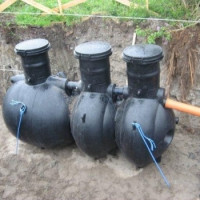 The device of a septic tank: the principle of operation and basic organization schemes
The device of a septic tank: the principle of operation and basic organization schemes  How much does it cost to connect gas to a private house: the price of organizing gas supply
How much does it cost to connect gas to a private house: the price of organizing gas supply  The best washing machines with dryer: model rating and customer tips
The best washing machines with dryer: model rating and customer tips  What is the color temperature of light and the nuances of choosing the temperature of the lamps to suit your needs
What is the color temperature of light and the nuances of choosing the temperature of the lamps to suit your needs  Replacement of a geyser in an apartment: replacement paperwork + basic norms and requirements
Replacement of a geyser in an apartment: replacement paperwork + basic norms and requirements
Great method.
This is really a great way. I process sewage myself using this method, it really works perfectly and quickly. These bacteria do their job very well. Don’t worry, they are really completely harmless, I’m somehow alive. But before you start the processing process itself, read everything that is written here. You need to know how to do this, under what conditions to store these bacteria, etc.
Of all the tried biological products, the best result was shown by the “Russian Athlete”. The smell disappeared already on the second day and the pumping of the septic tank also refused, because Bacter and decompose all the organics. I advise a productive drug.